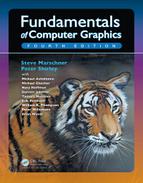Preface
This edition of Fundamentals of Computer Graphics includes substantial rewrites of the chapters on textures and graphics hardware, as well as many corrections throughout. The figures are now in color throughout the book.
The organization of the book remains substantially similar to the third edition. In our thinking, Chapters 2 through 8 constitute the “core core,” taking the straight and narrow path through what is absolutely required for understanding how images get onto the screen using the complementary approaches of ray tracing and rasterization. Ray tracing is covered first, since it is the simplest way to generate images of 3D scenes, followed by the mathematical machinery required for the graphics pipeline, then the pipeline itself. After that, the “outer core” covers other topics that would commonly be included in an introductory class, such as sampling theory, texture mapping, spatial data structures, and splines. Starting with Chapter 15 is a number of contributed chapters, authored by contributors we have chosen both for their expertise and for their clear way of expressing ideas.
As we have revised this book over the years, we have endeavored to retain the informal, intuitive style of presentation that characterizes the earlier editions, while at the same time improving consistency, precision, and completeness. We hope the reader will find the result is an appealing platform for a variety of courses in computer graphics.
About the Cover
The cover image is from Tiger in the Water by J. W. Baker (brushed and air-brushed acrylic on canvas, 16” by 20”, www.jwbart.com).
The subject of a tiger is a reference to a wonderful talk given by Alain Fournier (1943–2000) at a workshop at Cornell University in 1998. His talk was an evocative verbal description of the movements of a tiger. He summarized his point:
Even though modelling and rendering in computer graphics have been improved tremendously in the past 35 years, we are still not at the point where we can model automatically a tiger swimming in the river in all its glorious details. By automatically I mean in a way that does not need careful manual tweaking by an artist/expert.
The bad news is that we have still a long way to go.
The good news is that we have still a long way to go.
Online Resources
The website for this book is http://www.cs.cornell.edu/~srm/fcg4/. We will continue to maintain a list of errata and links to courses that use the book, as well as teaching materials that match the book’s style. Most of the figures in this book are in Adobe Illustrator format, and we would be happy to convert specific figures into portable formats on request. Please feel free to contact us at [email protected] or [email protected].
Acknowledgments
The following people have provided helpful information, comments, or feedback about the various editions of this book: Ahmet Oğuz Akyüz, Josh Andersen, Zeferino Andrade, Kavita Bala, Adam Berger, Adeel Bhutta, Solomon Boulos, Stephen Chenney, Michael Coblenz, Greg Coombe, Frederic Cremer, Brian Curtin, Dave Edwards, Jonathon Evans, Karen Feinauer, Amy Gooch, Eungyoung Han, Chuck Hansen, Andy Hanson, Razen Al Harbi, Dave Hart, John Hart, John “Spike” Hughes, Helen Hu, Vicki Interrante, Wenzel Jakob, Doug James, Henrik Wann Jensen, Shi Jin, Mark Johnson, Ray Jones, Revant Kapoor, Kristin Kerr, Erum Arif Khan, Mark Kilgard, Dylan Lacewell, Mathias Lang, Philippe Laval, Marc Levoy, Howard Lo, Joann Luu, Ron Metoyer, Keith Morley, Eric Mortensen, Koji Nakamaru, Micah Neilson, Blake Nelson, Michael Nikel-sky, James O’Brien, Steve Parker, Sumanta Pattanaik, Matt Pharr, Peter Poulos, Shaun Ramsey, Rich Riesenfeld, Nate Robins, Nan Schaller, Chris Schryvers, Tom Sederberg, Richard Sharp, Sarah Shirley, Peter-Pike Sloan, Hannah Story, Tony Tahbaz, Jan-Phillip Tiesel, Bruce Walter, Alex Williams, Amy Williams, Chris Wyman, and Kate Zebrose.
Ching-Kuang Shene and David Solomon allowed us to borrow their examples. Henrik Wann Jensen, Eric Levin, Matt Pharr, and Jason Waltman generously provided images. Brandon Mansfield helped improve the discussion of hierarchical bounding volumes for ray tracing. Philip Greenspun (philip.greenspun.com) kindly allowed us to use his photographs. John “Spike” Hughes helped improve the discussion of sampling theory. Wenzel Jakob’s Mitsuba renderer was invaluable in creating many figures. We are extremely thankful to J. W. Baker for helping create the cover Pete envisioned. In addition to being a talented artist, he was a great pleasure to work with personally.
Many works that were helpful in preparing this book are cited in the chapter notes. However, a few key texts that influenced the content and presentation deserve special recognition here. These include the two classic computer graphics texts from which we both learned the basics: Computer Graphics: Principles & Practice (Foley, Van Dam, Feiner, & Hughes, 1990) and Computer Graphics (Hearn & Baker, 1986). Other texts include both of Alan Watt’s influential books (Watt, 1993, 1991), Hill’s Computer Graphics Using OpenGL (Francis S. Hill, 2000), Angel’s Interactive Computer Graphics: A Top-Down Approach Using OpenGL (Angel, 2002), Hugues Hoppe’s University of Washington dissertation (Hoppe, 1994), and Rogers’ two excellent graphics texts (D. F. Rogers, 1985, 1989).
We would like to especially thank Alice and Klaus Peters for encouraging Pete to write the first edition of this book and for their great skill in bringing a book to fruition. Their patience with the authors and their dedication to making their books the best they can be has been instrumental in making this book what it is. This book certainly would not exist without their extraordinary efforts.
Salt Lake City, Utah
Ithaca, New York
February 2015
